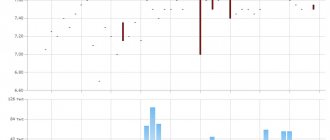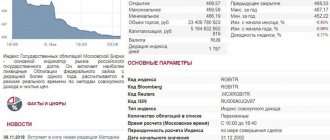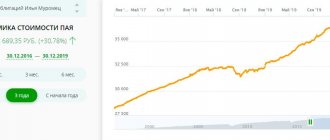Which edition is better and how to choose it
Two issues of municipal bonds are relevant for purchase - these are “Republic of Mordovia bonds series 34002” and “Mordovia series 34003”.
Until recently, these instruments made it possible to record higher returns after the credit rating of the Mordovia region was downgraded by the ACRA agency and indications of the risks of default on their bonds.
At that time, the instruments were traded in the area of the 101st figure and brought in more than 10% of the coupon income, however, after state support of the financial structure of Mordovia, the price of the bond increased, and the yield, accordingly, decreased.
I recommend looking towards the later issue Mordovia 03, as they provide slightly higher current yields and have a higher level of liquidity.
If we talk about what criteria an investor should pay attention to when independently analyzing bonds, then it is worth identifying the following factors:
- financial condition and credit ratings of the issuer;
- type of circulation of securities (exchange and over-the-counter);
- the amount of coupons and depreciation;
- current yield (relative to current quotes);
- frequency of payments;
- the presence of additional conditions (offers, conversion, etc.).
What is bond insurance?
Bond insurance is a type of insurance policy purchased by a bond issuer that guarantees payment of principal and all related interest payments to bondholders in the event of default.
Bond issuers will purchase this type of insurance to improve their credit ratings, reduce the amount of interest they have to pay and make the bonds more attractive to potential investors. Bond insurance is sometimes also called financial guarantee insurance.
Key Findings
- Bond insurance protects borrowers against default by the issuer by guaranteeing payment of principal and sometimes interest.
- Bond issuers who purchase this type of insurance may end up with higher credit ratings on those bonds, making them more attractive to some investors.
- Bond insurance is most often found among municipal bonds and asset-backed securities.
Types of OFZ
- OFZ with a constant fixed coupon (OFZ-PD). The coupon rate is set at the time the OFZ is issued and does not change until the bond is redeemed. This is the best option for a novice investor from my point of view.
- OFZ and indexed denomination (OFZ-IN) - annual indexation to the level of inflation is provided.
- OFZ with a variable coupon (OFZ-PK) - the coupon rate depends on market rates.
- OFZ with an amortizing coupon (OFZ-AD) - repayment of the bond's par value in installments.
Topic: How to choose OFZ | Purchasing federal loan bonds on the stock exchange
OFZ
Federal bonds are one of the most conservative instruments in the stock market. Their purchase provides investors with the opportunity to fix the interest rate for a long period and receive their guaranteed income.
Now, when due to investor fears and expectations of an increase in the Central Bank rate, the value of OFZs has crept down, you can get a good profitability.
I have listed the most profitable OFZs, which can provide income much higher than a bank deposit, in the table.
Selection parameters:
- issue in circulation;
- coupon type – permanent;
- depreciation – absent;
- OFZs are available for purchase by individuals;
- without an offer.
As a result, the following most profitable OFZs of 2021 were found:
| Release | Cost, in rubles | NKD, in rubles | maturity date | Coupon | Effective yield to maturity |
| Belarus-04-ob | 999,6 | 9,72 | 03.08.2022 | 8,65% | 9,33% |
| Belarus-03-ob | 995,5 | 9,72 | 03.08.2022 | 8,65% | 9,05% |
| OFZ-26230 | 967,6 | 33,75 | 16.03.2039 | 7,7% | 8,20% |
| OFZ-26225 | 937,6 | 22,05 | 10.05.2034 | 7,25% | 8,15% |
| OFZ-26221 | 977,2 | 33,75 | 23.03.2033 | 7,7% | 8,14% |
| OFZ-26228 | 981,3 | 30,6 | 10.04.2030 | 7,65% | 8,08% |
| OFZ-26218 | 1045,8 | 38,89 | 17.09.2031 | 8,5% | 8,04% |
| OFZ-26226 | 1009,6 | 33,32 | 07.10.2026 | 7,95% | 7,91% |
| OFZ-26219 | 1000,4 | 36,94 | 16.09.2026 | 7,75% | 7,89% |
| OFZ-26212 | 960,1 | 9,27 | 19.01.2028 | 7,05% | 7,89% |
| OFZ-26224 | 947,1 | 19,66 | 23.05.2029 | 6,9% | 7,86% |
| OFZ-26207 | 1030,1 | 7,59 | 03.02.2027 | 8,15% | 7,72% |
| OFZ-26229 | 981,4 | 23,11 | 12.11.2025 | 7,15% | 7,70% |
| OFZ-26227 | 995,7 | 11,15 | 17.07.2024 | 7,4% | 7,66% |
| OFZ-26222 | 984,7 | 28,4 | 16.10.2024 | 7,1% | 7,64% |
| OFZ-26223 | 966,8 | 2,32 | 28.02.2024 | 6,5% | 7,63% |
| OFZ-26232 | 916,5 | 17,09 | 06.10.2027 | 6% | 7,61% |
And here’s another interesting article: What are discount bonds, who issues them and why?
Notes:
1) The effective yield to maturity is the total return you would receive if you held the bond to maturity and reinvested all the coupons into the same issue.
2) The par value of all bonds is 1000 rubles.
3) The frequency of coupon payments for all bonds is 2 times a year.
As you can see, when choosing the most profitable OFZs, you should not rely on the value of the coupon, but take into account the effective yield to maturity (naturally, if you are going to hold the OFZs until maturity and reinvest the profit).
You also need to consider the repayment period. As a rule, the most profitable OFZs are those with the longest maturity. The closer to maturity, the less profitable government securities are.
Bond valuation indicators
The most reliable way to invest in the securities market is to invest in bonds.
This instrument is recommended for those who are interested in the complete safety of their capital with a higher income than on a bank deposit. Note 1
Compared to shares, bonds are the safest investment instrument, since their owners have priority in claiming a share of the company's property in the event of its bankruptcy or liquidation. For issuers, bonds are a reliable alternative to banks and other lenders.
When investing in bonds, you should pay attention to key indicators such as maturity, call conditions, credit quality, interest rate, price, yield, tax status. All these factors, taken together, allow the investor to assess the real value of debt obligations and make a decision about the degree to which this type of investment corresponds to investment goals.
Finished works on a similar topic
- Coursework Bond insurance 490 rub.
- Abstract Bond insurance 250 rub.
- Test paper Insurance of bonds 230 rub.
Receive completed work or specialist advice on your educational project Find out the cost
The maturity date is the predetermined date on which the face value of the bond will be returned to the investor. Bond maturities typically range from one to 30 years. The repayment period can be short-term (up to 5 years), medium-term (5-12 years) and long-term (12 or more years).
Some bonds contain a call provision under which the issuer can buy the bond back from the investor before maturity.
Investors from bonds receive interest income. They can be fixed, floating or payable before maturity. Most debt obligations have a fixed interest rate.
Some investors prefer to have securities for which the interest rate can be adjusted.
Each bond has a different credit quality, ranging from Treasuries that are fully guaranteed by the government to below investment grade. Along with the bond issue, the issuer provides detailed information about its position and level of solvency.
Need help creating a study plan? Specify a topic and receive a response in 15 minutes get help
The credit quality of a bond can be improved by insuring it, which assures investors of timely payments of principal and interest.
Note 2
Some bonds offer tax advantages to investors.
The price of a bond depends on a large number of variables, including interest rates, supply and demand, credit quality, maturity, and tax status.
When investing in bonds, you must take into account that investment returns are always associated with risks. The higher the risks, the higher the profitability, and vice versa.
It will be useful!
——————-
Where and how the MoneyPap family invests (successfully) (PDF) . In this document, I honestly tell you what profitable instruments my family invests in. Download the PDF for free - here.
——————-
Excel spreadsheet for ✔ Accounting, ✔ Control and ✔ Monitoring of investment portfolio + Video instructions. I didn’t find anything similar in the free and paid options and created my own table, which I’ve been using for many years . The price for everything is 180 rubles! Find out more here.
——————-
20 Financial Forms, Tables and Calculators for Independent Total Financial Management. I have been creating these shapes for many years. I'm giving it away for the price of a couple of cups of coffee - 179 rubles! Best-seller! See here .
Where can you buy bonds and how to get income?
They can be purchased using a simplified scheme: in authorized banks - Sberbank and VTB24.
One bond will cost one thousand rubles. The minimum amount that can be invested in such securities is 30 thousand rubles. The maximum within one issue is 25 million rubles.
The bonds will be three-year. This means that you will receive the maximum income if you remain the owner of the bonds for all three years. If, having bought bonds, for some reason you decide to present them for redemption, that is, you want to return them and get your money back, it makes sense to wait at least a year. In this case, you will receive interest accrued for 12 months.
Bond insurance clarification
The rating of a debt instrument takes into account the creditworthiness of the issuer. The riskier an issuer is considered, the lower its credit rating and, therefore, the higher the return investors expect from investing in a debt security. Such issuers face higher borrowing costs than companies that are rated as stable and less risky. To obtain a more favorable rating and attract more investors to issue bonds, companies may undergo a credit enhancement process.
Credit enhancement is a method used by a borrower to improve his debt or creditworthiness in order to obtain better terms for repaying his debt. One method that can be used to enhance credit is bond insurance, which typically results in the insured security being rated higher than the insurer's claims payout rating and the uninsured bond's rating, also known as the underlying rating. Bond insurance is a type of insurance purchased by a bond issuer to ensure payment of principal and all related scheduled interest payments to bondholders in the event of default. The insurance company takes into account the issuer's risk to determine the amount of premium that will be paid to the insurer as compensation.
Other Considerations
Bond insurers generally only insure securities that are rated basic in the investment grade category, with non-elevated credit ratings ranging from BBB to AAA. Once bond insurance has been purchased, the issuer's bond rating will no longer apply, and instead, the bond insurer's credit rating will apply to the bond rather than to the notch above it. By design, bondholders should not face significant problems if the issuer of a bond in their portfolio defaults. The insurer shall automatically assume the obligation and make any payments of principal and interest on that matter in the future.
Bond insurance is typically purchased in connection with a new issue of municipal securities. In addition, bond insurance may apply to infrastructure bonds, such as those issued to finance public-private partnerships, non-U.S. regulated utilities, and asset-backed securities (ABS).
Where to view the data
All information on bonds is available in the trading terminal or broker application. In addition, there are several websites that specialize specifically in bonds. On them you can see the profitability, upcoming coupon payments, maturity and other parameters.
List of bond sites:
- Moscow Exchange here
- smart-lab.ru
- rusbonds.ru
- cbr.ru
- cbonds.ru
Some of the information on these sites is paid. But basic free information is enough for ordinary investors.
Corporate bonds
The most popular among all bonds in 2021 with the highest yield are bonds of the corporate sector. They are the ones who can give investors the greatest profit.
However, it is impossible to simply identify the most profitable corporate bonds of 2021: among them there will be many junk bonds in a pre-default state. If you fill your portfolio with such bonds, nothing good will come of it - instead of maximum profitability, you will get continuous losses, especially in the current situation.
Therefore, I limited the maximum rate on corporate bonds to twice the risk-free rate of the Russian stock market (its value is about 7%, therefore, I limited the coupon yield of bonds to 14%).
I also excluded bonds from the list:
- with variable income;
- depreciation;
- offer;
- excessively long (maturity date – until 01/01/2027, i.e. all bonds from the list will be repaid within the next 6 years);
- too short (removed bonds maturing in 2021 so that they had time to work a little in your portfolios).
In addition, I used common sense in excluding issuers with too much debt or those with a history of default. If the issuer has several issues, then I chose one with the maximum yield.
The face value of all bonds in the table is 1,000 rubles (except for Uncle Döner - he has 10,000).
As a result, I compiled a list of the 20 most profitable corporate bonds of 2021:
| Issue name | Number of payments per year | Market price, rubles | NKD, in rubles | maturity date | Coupon | Effect. yield to maturity |
| DirectLeasing-001R-03 | 2 | 943,1 | 18,79 | 26.10.2021 | 14% | 19,41% |
| FPK Garant-Invest-001R-06 | 4 | 894,9 | 13.12.2022 | 13,5% | 17,36% | |
| Solid-Leasing-BO-001R-06 | 4 | 937 | 29,92 | 20.12.2022 | 13% | 16,83% |
| Red soft-001R-02 | 4 | 976,7 | 12,21 | 13.05.2021 | 13,5% | 16,68% |
| EconomyLeasing-001R-01 | 4 | 955,5 | 7,4 | 24.08.2022 | 13,5% | 16,68% |
| Aircraft GK-BO-PO-7 | 4 | 938,4 | 18,08 | 19.10.2022 | 12% | 15,76% |
| Agrofirm Rubezh-001R-01 | 2 | 977,5 | 26,47 | 06.07.2022 | 14% | 15,74% |
| Pawnshop Master-BO-P07 | 4 | 987 | 9,97 | 17.02.2022 | 14% | 15,62% |
| Uncle Döner-BO-P02 | 12 | 9850 | 22,19 | 25.04.2023 | 13,5% | 15,05% |
| Rolf-001R-02 | 4 | 918,6 | 4,64 | 24.02.2022 | 9% | 14,58% |
| RSG-Finance-11 | 2 | 998,9 | 10,85 | 18.08.2022 | 10,85% | 12,35% |
| Gazprom Neft-001Р-05R | 2 | 850 | 17,93 | 16.12.2024 | 7,7% | 12,27% |
| SoftLine Trade-001R-02 | 2 | 989 | 25,01 | 22.12.2021 | 11% | 2,02% |
| VEB RF-001R-01 | 1 | 1000,5 | 6,99 | 17.02.2025 | 11,6% | 11,58% |
| PIK GK-BO-PO7 | 2 | 972 | 19,31 | 25.06.2021 | 8,7% | 11,40% |
| Settle Group-001R | 4 | 998,9 | 16,49 | 17.01.2023 | 10,75% | 11,24% |
| Credit Europe-001R | 4 | 960,4 | 16,52 | 07.10.2022 | 9% | 11,23% |
| Domodedovo-FF-001R | 2 | 939,9 | 18,64 | 20.12.2022 | 8,1% | 11,12% |
| RESO-Leasing-BO-P-02 | 2 | 984 | 5,05 | 24.02.2022 | 9,7% | 10,91% |
| RSHB-28-ob | 4 | 1047,7 | 29,27 | 22.12.2021 | 12,87% | 10,27% |
Here's another interesting article: The best ETFs with monthly dividend payments
Again, this is not individual investment advice and you should independently review each bond before adding it to your portfolio.
Thus, there are plenty of income bonds in 2021. These include OFZs, municipal bonds, and corporate bonds of more or less reliable issuers. Enough to form a portfolio with constant income. But you need to choose specific bonds for your portfolio with caution, especially corporate ones - in conditions of financial instability, the probability of default increases many times over. On the other hand, only now it is possible to obtain a return significantly higher than a bank deposit and even the risk-free rate of the stock market. Good luck, and may the money be with you!
Rate this article
[Total votes: 2 Average rating: 5]
Taxes and IIS on Russian bonds
The state will withhold 13% tax from you on the bond income received. The following are subject to taxation:
- coupon payments;
- exchange rate difference between buying and selling.
- From 2021, all coupons of all bonds are subject to tax at a rate of 13% for residents and 30% for non-residents. The entire coupon is taxed—but only the coupon, not the value of the bond. There are no exceptions based on the type of issuer, coupon rate or amount of income received. Accordingly, coupon income on OFZs is also taxed.
- You can buy bonds on an IIS and receive an additional 13% of the amount of funds you invested in the IIS, in addition to the profitability of the bonds themselves.
- The tax on the coupon (and on the profit from the sale of bonds at a higher price) can be minimized using IIS type B.
- The broker independently withholds taxes at the time you receive money from the coupon.
Why are bonds issued?
Issuers issue bonds in order to attract cheaper borrowed funds compared to bank loans.
PDF Little-known Lifehacks of advanced investors on IIS accounts. How to get 5 deductions in 3 years, instead of 3? How to get 2 deductions per year, instead of one? How to withdraw money from an IIS ahead of schedule? How to triple your deduction in a year? And other life hacks! Download for free here.
Important
- The yield on bonds almost always exceeds the yield on bank deposits.
- The accumulated coupon income is always returned to the previous owner. Those. By selling the bond you will receive the coupon income earned before the sale. With deposits, interest is almost always lost (although there are deposits that, if closed early, retain part of the income). This is one of the most important advantages over bank deposits.
- The price of the bond can rise and fall, but at maturity you will receive the par value. Those. towards the end of the circulation period, the price returns to par.
- With bonds you can lock in returns for 3-5-10-20-30 years. Deposits, as a rule, have a shorter term (1-2-3 years), after which the deposit may be renewed at a completely different (for example, decreased) rate.
- In a difficult situation, you can sell part of the bonds. It is often impossible to withdraw money from a deposit without losing accumulated interest.
- Investments in bonds are NOT insured, unlike deposits that are insured by the DIA.
Bond classification
- State (OFZ)
- issued by the Ministry of Finance. Available from 1 year to 30 years. Denomination: 1,000 rubles. - Municipal or subfederal
- issued by local (regional) authorities. For example, bonds of the Moscow or Leningrad region. - Corporate
- issued by commercial companies, for example Sberbank, Lukoil, Gazprom. - Eurobonds
are denominated in foreign currency (usually dollars, some in euros).









